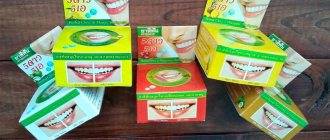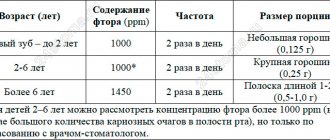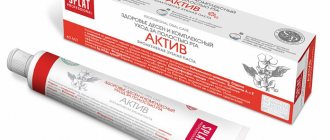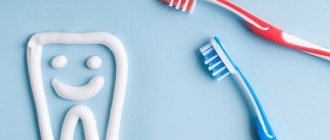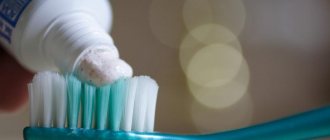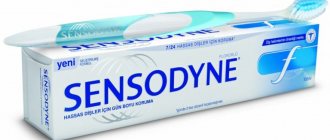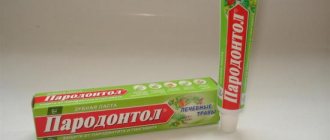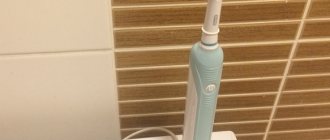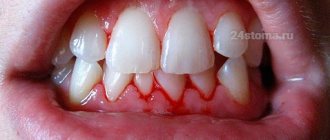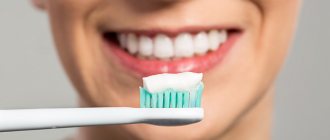If your baby has only erupted his first baby tooth, even that tooth still needs to be looked after. Any dentist will confirm this, because the subsequent correct formation of the molars depends on the condition of the baby teeth. This means that already with the child’s first tooth, parents are faced with the question of how to choose children’s toothpaste.
As a rule, it is quite easy to recognize children's toothpaste in a pharmacy window: its packaging is always brighter and more “cheerful” in design than that of discreet options for adults.
The taste of baby paste is formed in such a way as to reduce the risk of a gag reflex in the baby. Some brands, in order to win over children's audiences, accompany their packaging with entertainment materials and toys. These can be coloring books, calendars, comics.
However, of course, all of the above is rather an advertising and psychological tool that should not play a decisive role in deciding which pasta to choose for a child.
First of all, you should understand that “adult” toothpastes or “for the whole family” options are not suitable for children. Such products can only be used from 14 years of age. Although they practically do not differ in composition, the concentration of certain substances in them is too high for the child’s body. It follows from this that the first criterion that you should follow when choosing a toothpaste is the age of your child. Below we will consider the gradation of pastes according to this criterion.
Paste gradation
Pastes for children under 4 years old
- Toothpaste for babies should guarantee careful and high-quality cleaning of baby teeth. There is a parameter for the degree of abrasiveness RDA, and in this case it should not exceed 20 units.
- In addition, the paste must be safe in case the baby accidentally swallows it. Children of this age, as a rule, do not yet know how to rinse their mouths, so up to a third of the tube is actually swallowed by them.
- The fluorine content for the specified age is no more than 200 ppm, or there is none at all.
Pastes for children 4-8 years old
- During this period, children's baby teeth are gradually replaced by molars. This means that the paste must be suitable for both. Ideally, it should reduce the risk of caries and the not very pleasant sensations that children experience when changing teeth.
- RDA abrasiveness index – no more than 50 units. Young enamel should not be injured.
- Fluorine concentration – no more than 500 ppm.
Pastes for the age group 8-14 years
- The child is approaching adolescence, and the molars are already completely replacing the milk teeth. The fluoride concentration in pastes for this period is approaching adult levels and is about 1400 ppm.
- The degree of abrasiveness is no more than 50 units.
Now let's take a closer look at what is included in children's pastes.
Features of the structure of milk teeth
This is what determines the choice of toothpaste depending on the age of the child.
The enamel of a molar tooth consists of 97% minerals; in a baby tooth this figure is 30% lower. Enamel and dentin in children practically merge, and they are thinner and softer than in adults; accordingly, caries can develop much faster and result in pulpitis.
The enamel of a baby tooth is not a static element; processes of remineralization and demineralization constantly occur in it—the entry and destruction of microelements.
The pulp of primary teeth is quite large compared to molars, and the root canals are wide, so the infection can spread inside the tooth quite quickly, and lymphatic vessels and nerves can also be involved in the inflammatory process.
Often children do not experience pain even when their teeth are deeply damaged by caries (pulpitis), since the immature loose tissue of the tooth is destroyed rapidly and does not have time to send a pain signal to the brain.
Abrasives
So, we found out that children's toothpaste should clean baby and molar teeth, taking into account their differences, carefully and efficiently. The decisive factor in the quality of cleaning is abrasiveness, which depends on the specific substance contained in the paste.
The most common abrasives are sodium bicarbonate and calcium carbonate. In common parlance - soda and chalk. Please note that these are aggressive components that can damage the delicate enamel of children's teeth.
We recommend choosing brands that contain abrasive components such as silica and titanium dioxide. They are found in Lacalut, Dragon, ROCS, Oral-B, and Colgate toothpastes.
Alas, not all brands indicate the RDA abrasiveness parameter. You can see it on the President and ROCS packages
The best toothpastes for children 7, 8, 9, 10, 11, 12 years old
PresiDENT Junior Wild Strawberry 6+ without fluoride
- One of the most delicious
- Country: Italy
- Price: 137 RUR
- Fluoride: No
- Volume: 50ml
- Rating (2021): 8
Toothpaste should be used by children aged 6 to 12 years. The product does not contain fluoride, so it is suitable for milk teeth that have not yet been replaced. It also contains no SLS, parabens or allergens. Contains natural sweetener and colorings. Buyers write that their children enjoy brushing their teeth, thanks to the strawberry taste and aroma. After use, plaque is removed and a feeling of cleanliness and freshness remains.
- Advantages
- Without fluoride
- Without SLS
- Gel consistency
- Price
- Pleasant taste
Elmex Junior
- Fluoride-containing paste, the best against caries
- Country: Germany
- Price: 199 RUR
- Fluorine: Yes
- Volume: 75ml
- Rating (2021): 9
The toothpaste is intended for children with permanent teeth from 6 to 12 years old. The fluoride content is 1400pm, which helps to safely strengthen the enamel and protect against acids. The product is white in color with a mint flavor. Most buyers are satisfied with the paste purchased on the recommendation of a dentist. They also note that the product protects against caries and has a whitening effect.
- Advantages
- Price-quality ratio
- No dyes
- No preservatives
- Pleasant taste
- Good sealed packaging
Biorepair Junior Mint for children with sweet mint flavor
- The best whitening
- Country: Italy
- Price: 400 RUR
- Fluoride: No
- Volume: 75 ml
- Rating (2021): 10
The toothpaste is intended for children from 7 to 14 years old. It contains no fluoride, SLS, fragrances or parabens. The product has anticaries, remineralizing, antimicrobial and anti-inflammatory effects. The composition also contains hydroxyapatite microcrystals (Microrepair), which form dentin and enamel.
There are many positive reviews and recommendations from dentists on the Internet. Mostly, users note a delicate minty taste that does not leave a burning sensation. Biorepair Junior Mint cleanses plaque well, promotes whitening and restores damaged enamel.
- Advantages
- Without fluoride
- No dyes
- Pleasant taste
- Foams just right
- Economical consumption
Fluorine
Typically, toothpastes with fluoride are recommended for use in areas of residence with low levels of this element in drinking water. However, even in this case, experts’ views on the need to use children’s toothpastes with fluoride differ.
Fluorine is still a rather toxic element and can pose a health hazard. As we have already written, children often swallow toothpaste. As a result, instead of having a beneficial effect on the teeth, fluoride has a harmful effect on the esophagus. The risk of fluorosis, hypothyroidism and a number of other serious diseases increases.
This means that children's toothpaste must contain the amount of fluoride that meets the standards - or do without it at all. When wondering what toothpaste to use to brush your child’s teeth, consult a doctor.
At what age should you start taking care of your teeth?
Some dentists recommend treating even a baby’s toothless gums starting at 4 months of age.
to remove milk deposits. For a hygienic procedure, just wrap gauze soaked in boiled water around your finger and wipe the outer and inner surfaces of the gums.
But most doctors recommend starting care from the moment the first tooth appears. Before a year, you should use gauze or a special fingertip; after a year, brush your teeth with a toothbrush and toothpaste.
Antibacterial components
The main components with antibacterial properties used in children's toothpastes are chlorhexidine, triclosan and metronidazole.
The catch is that these substances deal not only with harmful bacteria, but also with beneficial ones. As a result, the microflora of the child’s oral cavity is disrupted.
Toothpaste with the listed substances should be used only under the supervision of a doctor and according to his recommendations.
If your child does not have gingivitis, periodontitis, stomatitis and other diseases, then it is better to choose toothpaste without antibacterial components.
Useful material
But what should be in a high-quality toothpaste for children are milk enzymes: lactoferrin, lactoperoxidase, lysozyme, glucose oxide - all of them help strengthen the baby’s immunity and enhance the protective properties of saliva. Natural protein casein is also added to children's pastes, which contribute to the accumulation of calcium in the enamel layers. If the paste contains a small percentage of fluoride, then it must be present in organic form - this component is prescribed in the composition as olaflur or aminofluoride.
Toothpaste is an essential hygiene product for children's teeth, but its role in the prevention of caries in children is often greatly exaggerated. Regular and high-quality oral hygiene in children, preventive dental examinations and proper nutrition are much more important here. When buying another tube for your child, think: what is behind the beautiful packaging and tempting advertising promises? Choose a toothpaste with the most natural, simple composition, and it is best to buy it in a pharmacy or specialty store.
Foaming components
The key functions of such components are to moisturize the surface of the teeth, create foam and maintain an even consistency of the composition for easier cleaning.
The most well-known foaming agent is sodium lauryl sulfate (SLS, E 487). Unfortunately, it does more harm than good. This component is toxic, it has a drying effect on the mucous membrane, and in addition, it can cause allergies. However, it is contained in pastes of the brands Colgate, Aquafresh, Glister, Blen-da-Med, Rembrandt.
Sodium laureth sulfate (SLS), which is less irritating, can be used instead.
In fact, foam does not have a significant effect on the cleaning result. So when choosing a toothpaste for a child, at least make sure that it does not contain sodium lauryl sulfate.
Flavors
To remove unpleasant taste, toothpastes for children include flavoring fillers. It can be fruity or neutral. Sweeteners (xylitol and saccharin) are added to the product. Sometimes, one component can perform both functions - taste and smell.
Did you know? There are multi-colored squares on the bottom of the toothpaste tube.
What do they mean:
- Black color of the square - the paste contains only chemicals
- Red – chemicals and natural substances
- Blue – 50% natural substances
- Green – only natural ingredients
Preservatives
Preservatives are added to pastes to prevent the proliferation of microflora during transportation, storage and use.
When you set out to buy children's toothpaste, check whether it contains sodium benzoate. This substance exhibits carcinogenic properties in high doses and is therefore even prohibited for use in a number of countries.
Propylene glycol (may be labeled on the packaging as PEG or PEG), best known as a de-icing agent, is also extremely harmful.
Finally, you should not choose toothpastes containing propylparaben. It is also a harmful carcinogen found in the Aquafresh Kids, My Sunshine and Colgate Doctor Hare brands.
Anna Mikhnina's blog
Mikhnina A.A.
I recently wrote about how to take care of children's dental health.
The article examined the necessary and sufficient stages of care to ensure the health of the enamel. And the need to use toothpaste was mentioned (from what age and what type of paste to use) - more on that here.
In this regard, it is important to talk about children's toothpaste in more detail. What toothpaste composition for a child can be considered safe and effective?
I’ll say right away that I’m not at all a fan of various eco, bio, organic and natural products. I approach them with a certain degree of skepticism. Therefore, I read labels on products, but not in search of eco-certification badges (although caring for nature is also not in last place on the list of my life priorities). And not looking for the marks “non-GMO”, Organic, something free, etc., but just studying what is present in the list of ingredients.
So what is in children's toothpaste? And what of this should you pay attention to when choosing it?
The minimum sufficient set of components of a modern toothpaste includes:
- surfactant (surfactant) for actual cleaning and foaming
- abrasive substance for removing hard deposits
- prophylactic or therapeutic-prophylactic substance
- preservative
- structurant
- flavoring and aromatic additives (sweeteners, flavorings), dyes
What may be included in each of the listed categories of substances:
1) Surfactants of different groups ( tensides
) - anionic, cationic, nonionic and amphoteric. It cannot be said that any of these categories is definitely bad or good, since they are always used in cosmetics (in particular in toothpaste) in mixture with each other, in addition, the level of their aggressiveness varies depending on the pH of the environment. The harmful effect on the skin and mucous membranes is a drying (degreasing) effect.
No horror stories about carcinogenic effects, accumulation in the brain, liver, etc., when used in accordance with the intended purpose (superficially or in the case of toothpastes in compliance with the standards for the maximum permissible amount) have not been clinically confirmed! Excessive amounts of aggressive surfactants in toothpaste can lead to stomatitis.
The most common anionic ones are SLS (Sodium Lauryl Sulphate), SLAS (Sodium Laureth Sulphate)
, the second is somewhat softer than the first, and therefore is generally preferable. Very mild in its action is sodium lauroyl sarcosinate
(Sodium Lauroyl Sarcosinate / Crodasinic LS30).
Nonionic surfactants are the mildest and also have 100% biodegradability. However, they are characterized by poor foaming in aqueous solutions, so they are mixed with anionic surfactants. This is, for example, Glyceryl Laurate .
, various ethoxylated alcohols:
(C12-C15), (C9-C11)
. They, as a rule, are superior to anionic surfactants in both cleaning and degreasing effects, therefore, based on the totality of their properties, they are the most preferable in the composition of children's toothpastes.
From the group of amphoteric surfactants, betaine derivatives are most often used, for example, cocaminopropyl betaine.
and
imidazoline (sodium cocoamphoacetate)
.
They have rather poor cleaning properties, so they are used as an addition to anionic or cationic surfactants to soften the aggressiveness of the former and enhance the effects of the latter. Amphoteric surfactants themselves are highly irritating to the skin components (superior in irritating properties to sodium lauryl sulfate), so it is better to avoid their presence in children's toothpaste: cocaminopropyl betaine, cyclimide, amidobetaine, alkyldimethylcarboxybetaine.
2) all toothpastes contain an abrasive substance - cleaning granules to remove hard bacterial plaque and prevent the deposition of tartar. The very first means for cleaning teeth from hard, stubborn stains was chalk. Dentifrice.
Now you can find a lot of articles about how healthy and natural it is to brush your teeth with chalk powder or some kind of natural, self-prepared tooth powder made from clay.
So chalk:
maximum permissible values of the RDA index of toothpastes (Radioactive Dentin Abrasion) - an indicator of the abrasion of tooth enamel in accordance with ISO 11609: pastes for children - 20-30, pastes for adults - 80-100, pastes for smokers - 120-150. RDA values of toothpastes containing various abrasives: chalk - 60-250, SiO2 - 10-150, Al2O3 - 120-150, Ca2P2O7 - 90-125. Thus, the minimum RDA value for chalk is significantly higher than the maximum RDA value allowed in toothpastes for children.
Control of the abrasiveness of chalk products (as well as products based on natural untreated clay) is made difficult by foreign inclusions that are inevitably present in natural limestone - the raw material for the production of chalk. In addition, chalk calcium interacts with surfactants included in pastes and reduces their activity, in particular, the effectiveness of fluorine-containing components.
Modern abrasives: silicon dioxide, aluminum hydroxide.
“The synthesis of silicon dioxide using a controlled structure method ensures the production of a material with a narrow particle size distribution, which allows, when developing toothpastes, to initially plan their abrasiveness” (quote from the site Propaedeutics of Internal Diseases). Silicon is neutral and does not react with other components of toothpaste.
Aluminum is capable of reacting with fluorides, forming insoluble salts if the toothpaste contains fluoride. In any case, ingesting metals does not benefit the body. He is extremely bad at getting them out. That's why I say no to aluminum hydroxide.
Bicarbonate of soda
- drinking soda. Actually it is not an abrasive (RDA = 7) [1]. But in children's toothpastes it can act in this capacity. The main effect is a weak antiseptic + creates a hypertonic environment in the mouth, which helps relieve swelling during teething.
Suitable for children's toothpastes aged 1-2 years. Children over 2 years old often develop hard plaque and caries, so they require more thorough cleaning.
In children's toothpaste, the presence of abrasives should be in strict accordance with recommendations for age groups. Children under 12 months. You should not brush your teeth with a toothpaste containing any abrasive component. We choose the most gentle composition without step 2.
Sometimes you can find information that titanium dioxide (TiO2)
also used in toothpastes as an abrasive. This is wrong!
The purpose of this substance is to give toothpaste a snow-white color. But only! Titanium dioxide (dioxide) is a dye approved for use in the food industry (additive E171). Or titanium white. (Wikipedia)
You will not find information about the use of titanium dioxide as an abrasive in industry. As for the official information about the purpose of titanium dioxide as an independent substance in cometology and food production, it is as follows: “for protection against ultraviolet radiation in sunscreens, for imparting a high whitening and covering effect (initial color) in toothpaste, soap and other cosmetic products, to give a high whitening and hiding effect to food products, to protect the color and packaging (plastic) of products from ultraviolet radiation.” [3] “The hiding power is taken to be the ability of a paint and varnish material to make the color or color differences of the surface being painted invisible” (GOST 8784-75 (ST SEV 5904-75)).
This component is not needed in children's toothpastes.
3) the preventive substance is responsible for the main purpose of this paste: prevention of caries, strengthening of enamel, prevention of periodontal diseases. Therapeutic treatment, accordingly, is designed to combat these problems if they have already arisen.
Additives for this purpose include:
- calcium (the most effectively penetrating form into tooth enamel is calcium lactate
, hereinafter
calcium hydroxyapatite
.) Please note that calcium citrate in toothpaste is not used as an active substance to enrich tooth enamel with calcium ions, but as a weak preservative with bacteriostatic properties. The release of calcium ions from this form requires the presence of acid. - fluoride (WHO recommended dosage of F in toothpaste for children 1-12 years old from regions that do not contain fluoride in water is 500ppm). The best form is amino fluoride
.
Next in terms of the rate of release of fluoride ions, which is critical for children who are unable to spend long minutes brushing their teeth, comes sodium fluoride
.
But monofluorophosphate
would be a poor choice for a children's toothpaste. Dissociation into ions and release of fluorine is slow.
- Xylitol
is a substance with a pronounced bacteriostatic effect against cariogenic microflora. Absolutely harmless to the human body.[5] - plant extracts and enzymes for antiseptic and hemostatic effects (bromelain, papain, herbal extracts and oils)
- aluminum (fights bleeding gums) - not recommended for children! Preference for medicinal herbal extracts.
- silicates for relieving tooth sensitivity
- And etc.
Which of these should be present in children's toothpaste depends on the specific dental problems of the child. Extra components are not desirable.
I consider calcium and fluoride to be essential. However, adding them to the paste is useless at the same time!
Fluorine and calcium, being in the same tube, react with each other and form an insoluble salt - calcium fluoride.
Therefore, pastes with fluoride and calcium need to be alternated. For both children and adults.
Xylitol is also very desirable, but it is usually present in high-quality pastes, simultaneously serving as a sweetener.
4) industrially prepared toothpaste without preservatives is a lie!
Sanitary and hygienic requirements for such products necessarily require the presence of substances that stabilize the microbiological composition and ensure the safety of their use during a certain (even the most minimal) shelf life.
Therefore, believe the inscription: “no preservatives!” not worth it.
Another question is what preservatives are used in toothpastes? The same ones that industry uses in food production. The most popular of them (scary word) are parabens.
Parabens
- natural derivatives of benzoic acid, found in large quantities in berries (for example, cranberries, blueberries). People have been using its preservative properties for over four hundred years.
Ethylparaben (E214), Methylparaben (E218),
used for food preservation. They can be found on the packaging of most confectionery products, sauces, mayonnaise, and canned food. And of course they are used in cosmetic preparations (for cosmetic preparations the maximum possible dosage is 0.4% for a single paraben and 0.8% if a mixture of parabens is used) [2].
In medicine, methyl and propyl parabens are called “Nipagin” and “Nipazol”, respectively. They are part of a huge number of medications. “The list of finished medicines containing parabens is endless. Thousands of therapeutic and therapeutic-and-prophylactic drugs in the form of ointments, emulsions, gelatin capsules, creams, gels, tinctures, decoctions, syrups, drops for the nose and eyes - everything that requires non-irritant action and a rapid bactericidal effect.” (Quote from the article “Parabens. Bet on safety.” S.A. Orlova, M.V. Dodonov, “Chemistry and Life”, Oct. 2011).
As for the safety of parabens, to date there is not a single study that has proven their harm. All controversial issues (in particular, the suspicion of carcinogenicity of parabens in cosmetics) were refuted by the medical community itself.
The European Consumer Protection Committee, based on an analysis of data from numerous clinical studies and medical statistics, has decided that methylparaben, ethylparaben, propylparaben, isobutylparaben and butylparaben are considered safe as components of cosmetic preparations in which the total concentration of parabens does not exceed 0.8%.
“All parabens are now approved for use in cosmetics in the EU countries, the USA and even in Japan, where health legislation is the strictest in the world.” (Quote from the article “Parabens. Bet on safety.” S.A. Orlova , M.V. Dodonov, “Chemistry and Life”, Oct. 2011).
Other preservatives: Formalin (formaldehyde)
- very toxic (but its carcinogenic effect is currently denied by the latest medical data). Its analogues. DMDM-hydantoin, bronopol, DOWECIL 200, diazolidinyl urea. Formaldehyde is also released in the aqueous solution.
Bronopol
. It enters into chemical reactions with amines and amides contained in cosmetics, forming carcinogenic nitrosamines.
Chloromethylisothiazolinone and methylisothiazolinone
– one of the most powerful preservatives. But they can cause allergic reactions and dermatitis.
Sodium benzoate
and
potassium sorbate
are long-known and widely used preservatives for food, household chemicals and cosmetics. But their effect on microorganisms is very weak, so they require the addition of other stronger preservatives to the formulation, or the product using them will have a very short shelf life.
benzyl 2-pyrrolidone-5-carboxylate (Twister), o-cumen-5-ol (Biosol). Information about their side effects is not yet sufficient to draw any conclusions. C5-C8 1,2-glycols, ethylhexylglycerol, 1,3-butylene glycol monopropionate. Non-toxic, non-sensitizing and non-irritating to the skin and mucous membranes. They have a pronounced fungicidal and bactericidal effect, but with a rather narrow spectrum. Therefore, they are used in mixtures with other preservatives (most often parabens).
I say “Yes” to parabens! 5) structure-forming substances in toothpaste [4]:
- Various gums - Gum (guar, xanthan, cellulose)
- Glycerin (propylene glycol, polyethylene glycol)
- Pectin, agar
- Potassium Chloride (potassium chloride) - viscosity regulator.
- Dextran (starch)
- Sodium alginate
- hydroxyethylcellulose, carboxymethylcellulose, methylcellulose, etc.
Of the most common ones listed above, I did not find anything about their harmfulness.[5]
6) flavorings, dyes, sweeteners.
- flavorings - any are harmless
- dyes - best avoided in toothpaste for children under 3 years of age
- sweeteners: the best and absolutely harmless is xylitol (Xsilyt, Xsilitol), it is not eaten by the cariogenic bacterium Streptococcus mutantis, then the least attractive for cariogenic microflora is Lactit, often found and also proven harmless Saccharin (Sodium Saccharinat), Sucralose ( Sucralose), Sorbitol, Mannitol, but they are quite loved by Streptococcus mutantis, so they are not the best choice for toothpaste.
Links: [1] - https://ezmedix.com.ua/articles/measurement-relative-by-dentin-a/ [2] - “Preservatives in cosmetics and hygiene products”/ Belikov O.E., Puchkova T. IN. Moscow, School of Cosmetic Chemists, 2003. – 250 p. [3] - https://www.newchemistry.ru/dobavka.php?id=45 [4] - https://ru.m.wikipedia.org/wiki/Toothpaste
[5] - https://www.ewg.org/skindeep
(
1 votes, average: 5.00 out of 5)
Flavoring fillers
Flavoring fillers are used in pastes to remove the effect of the not very pleasant taste of individual components. As a rule, menthol, various types of mint, eucalyptus, anise, vanillin and non-caries-stimulating sweeteners such as saccharin are used for this.
Some components, by the way, can perform a number of functions at once: they are both a sweetener and a flavoring agent.
In general, the paste contains artificial colors and saccharin.
Oral hygiene for children
Completely baby teeth erupt in a child by the age of 2-2.5 years. And some parents are sure that oral hygiene for toddlers should begin at the age of 3. However, it is not.
To avoid diseases, it is necessary to clean them as soon as the first teeth appear.
Unfortunately, baby teeth hurt! First, dark spots appear, then caries and soon pulpitis. To prevent this from happening, preventive measures are necessary. Brush your child's teeth 2 times a day. Best in the morning and evening.
Important! Baby's oral hygiene should begin when the first tooth appears. Without care, teeth begin to rot.
We must not forget that if children have carious teeth, infection occurs. It affects not only the nascent molars, but also the entire body of the child, which can lead to diseases such as sore throat or stomatitis.
Daily oral hygiene will help you avoid dental treatment. Although preventive examinations are mandatory.
